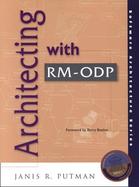Architecting With Rm-Odp
- List Price: $74.00
- Binding: Paperback
- Edition: 1
- Publisher: Prentice Hall
- Publish date: 10/01/2000
Description:
I. ARCHITECTING DISTRIBUTED PROCESSING SYSTEMS PRIMER. 1. Open, Distributed Processing, Architecture, and Architecting. Open System. Distributed Processing. Architecture and Architecting of Software-Intensive Distributed Processing Systems. Architecture Specification. Reference Model of Open Distributed Processing. Summary. 2. RM-ODP Manager''s Primer. Motivation for RM-ODP. Benefits Achievable from Using RM-ODP. Where RM-ODP Fits in the Lifecycle. How RM-ODP Is Used. How RM-ODP Facilitates Business Specification. RM-ODP Elements for Use. Prerequisite Skill Base. Investment Needed. Summary. 3. RM-ODP Architect''s Primer. More About RM-ODP. RM-ODP Concepts and Techniques for Use. How RM-ODP Is Used. Summary. 4. Tools, Relationships, and RM-ODP Standard. Tool Support and Limitations. Maturity of Use. RM-ODP Support. Relationship with OMG. RM-OSI and RM-ODP. Parts of the Standard. Summary. II. RM-ODP CONCEPTS AND RULES, AND THEIR USES. 5. RM-ODP Architecture Model. RM-ODP Architecture Model Overview. RM-ODP Viewpoints Overview. Using RM-ODP from a Domain-Specific Perspective. Use of RM-ODP Viewpoints. Distribution Transparency. ODP Functions. Essentials of the RM-ODP Object Model. Specification Concepts and Rules. Structuring Concepts and Rules. Conformance Concepts and Rules. Summary. 6. Separation of Concerns: Using RM-ODP Viewpoints. Overview of Separation of Concerns. Using the Enterprise Viewpoint. Using the Information Viewpoint. Using the Computational Viewpoint. Using the Engineering Viewpoint. Using the Technology Viewpoint. Summary. 7. Architecture Specification and Representation. Overview. Architecture Model. Specification, Representation, and Differences. RM-ODP Architecture Specification Concepts. Summary. 8. Composition and Semantics: Quality Composition Minimizing Architectural Mismatch. Overview. Semantic Behavior. Abstraction and Refinement. Components, Composition, and Decomposition. Architectural Mismatch. Minimizing Mismatch through Behavior Specification. Summary. 9. RM-ODP Functions. Purpose of the RM-ODP Functions. Open Specification: RM-ODP Component Standards. RM-ODP Function Categories and Function Dependencies. Management Functions. Coordination Functions. Repository Functions. Security Functions. Summary. 10. Hiding System Complexities: Distribution Transparencies. Purpose. Examples. Distribution Transparencies. Viewpoint Mechanisms. Summary. 11. Architecture Analysis and System Conformance Evaluation. Purpose of Consistency. What Is Meant by Consistency. Why Consistency Is Important. RM-ODP Consistency Rules. Conformance and Compliance Testing. Summary. III. PATTERNS FOR DISTRIBUTED PROCESSING CONCERNS. 12. Enterprise Business Specification. Importance. Using RM-ODP. Process of Specifying a Business. Healthy Hospital Enterprise Business Example Extended. Summary. 13. Interaction Framework: Interoperability. Motivation for the Interaction Framework. Interaction Framework Overview. About Interoperability. About Software Architecture Connectors. Interaction Framework. RM-ODP Definitions. Relationship Framework. Interfacing Framework. Binding Framework. Interception Framework. Behavioral Semantics Framework. Summary. 14. Policy Framework. What Is a Policy. Revisiting RM-ODP Concept of Policy. Examples of Policy Use. Policy Framework for Specifying a Policy. Tools to Represent a Policy. Summary. 15. Federation. What Is Federation. Why Federation Is Important. Considerations for a Federation. RM-ODP Constructs for Use in Specifying a Federation. Where Technology Is Today. Summary. 16. RM-ODP Fault Tolerance Framework. What Is Fault Tolerance. Importance of Fault Tolerance. Considerations to Achieve Reliability, Dependability, and Availability. RM-ODP Fault Tolerance Pattern of Reasoning. Fault Tolerant Model in UML and OCL. Summary. 17. Quality of Service Model. Purpose and Motivation. Quality of Service Example. What Is Quality of Service. Meeting QoS in Architecture. Emerging QoS Reference Model for RM-ODP. Work in the Area. Summary. IV. ARCHITECTING FRAMEWORKS, ARCHITECTING HEURISTICS, AND CONCLUSIONS. 18. Frameworks and Other Methods of Architecture. Architecture Methodology Selection Criteria. Architecture Methods. Summary. 19. Architecture Heuristics and Conclusion. Summary of the Contents of the Book. Concepts of Architecture. Heuristics to Remember. Emerging Technologies. Some Warnings. Comparison with Other Architecture Approaches. Wrapping Up. Glossary. Acronyms. References. Bibliography. World Wide Web Sites. Index.
Expand description
Product notice
Returnable at the third party seller's discretion and may come without consumable supplements like access codes, CD's, or workbooks.
| Seller | Condition | Comments | Price |
|
Wonder Book - Member ABAA/ILAB
|
Good |
$14.27
|

Please Wait

